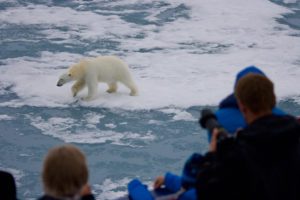
Press release from AECO – Association of Arctic Expedition Cruise Operators (01.11.17):
Seeing wildlife in its natural habitat is a major attraction for travelers visiting the Arctic. New Wildlife Guidelines from the Association of Arctic Expedition Cruise Operators (AECO) aim to help nature lovers enjoy the Arctic fauna safely and without disturbing the birds and animals that they are admiring.
From the iconic polar bear to the dainty, sparrow-like snow bunting, the Arctic’s unique wildlife is one of the region’s natural tourist attractions. But before you go scouting for walrus, puffins and belugas, there are a few things you should keep in mind. Following certain precautions will not only enable you to enjoy the sight of undisturbed wildlife, it will also keep both you and the wild creatures safe.
This week, Association of Arctic Expedition Cruise Operators (AECO) launched a set of Wildlife Guidelines, which give advice on how to act around the animals that you are likely to encounter in the Arctic. The guidelines, which cover walrus, seals, reindeer, Arctic fox, birds, polar bears and cetaceans (whales, dolphins and porpoises), contain both general information about the different species, and instructions how you should behave around them.
Practical know-how
“The Arctic is a captivating destination for animal lovers and birders. AECO’s Wildlife Guidelines explain how to observe and photograph wildlife without disturbing it,” says Frigg Jørgensen, executive director of AECO.
The guidelines translate expert knowledge about animal behavior into practical know-how that can be used in the field. Say you’re walking along an Arctic beach, and suddenly, an Arctic tern starts attacking you. What should you do? The guidelines will tell you that the bird is probably trying to protect a nearby nest, and that you should move away in the direction you came from. If you hold up your hand, or your hat, the bird will aim for that instead of your head.
The guidelines also contain information about animal behavior, recommended distances from different species, polar bear and walrus safety, and how to position a ship or a group of tourists to avoid alarming the animals.
Mandatory for AECO members
Following the Wildlife Guidelines is mandatory for all tour operators that are members of AECO.
“The goal of expedition cruising is to bring passengers close to nature, and it is important that we are responsible visitors. Our members have decades of experience in Arctic cruise tourism, and spotting birds and animals is often the highlight of the voyage. These Wildlife Guidelines are a way of systematizing the best practices of our members when it comes to responsible and considerate wildlife observations,” says Jørgensen.
The guidelines have been developed with the support of the Svalbard Environmental Protection Fund, and are available on AECO’s website.
AECO – Association of Arctic Expedition Cruise Operators
Association of Arctic Expedition Cruise Operators is an international organization for expedition cruise operators and associates in the Arctic, dedicated to managing environmentally-friendly, safe and considerate cruise tourism. The close to 70 international members, included 35 vessel operators, owners and management, and 40-45 expedition cruise vessels that are organized by AECO, represent the great majority of these operations in the Arctic.
Wildlife guidelines: https://www.aeco.no/wildlife-guidelines/
Svalbard environmental protection fund
The Svalbard environmental protection fund was established in 2001 under the Svalbard Environmental Protection Act. The fund’s resources will be used to initiate and stimulate projects with the purpose of protecting Svalbard’s environment. The fund is financed by dues and allocation, including the environmental fee paid by all visitors to Svalbard.
Contact
Edda Falk, communications manager, AECO – Association of Arctic Expedition Cruise Operators edda@aeco.no
www.aeco.no
Resources for download

